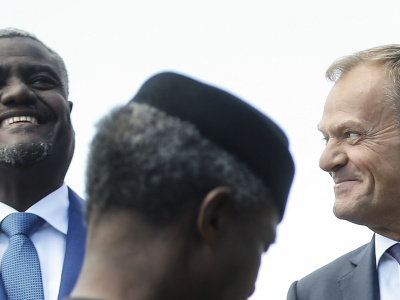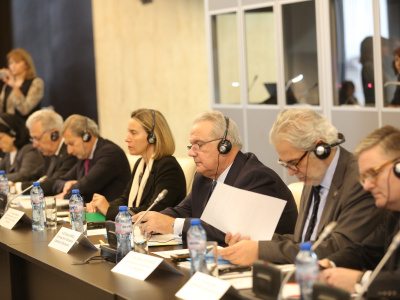
EU external action and development cooperation in the next EU budget: One instrument to play many tunes
On Monday 5 March, POLITICO woke us up with interesting reading: a letter signed by Commission President Juncker and Budget Commissioner Oettinger on the next Multiannual External Financial Framework (MFF) sent to all EU Commissioners. The letter argues for a budget that reflects EU priorities and ambitions and, more interestingly, its annex sheds light on the priorities, instruments and timelines of the next EU budget.
A single instrument (and a few more) for EU external action
In a recent Communication, published ahead of the informal leaders’ meeting of 23 February to discuss the long-term EU budget and institutional issues, the Commission suggested increasing the current volume for Global Europe, and the projection of EU interests and values abroad, beyond €100 billion. This includes the external financing instruments (EFIs) currently clustered under Heading 4 (worth €66 billion), as well as the European development fund (EDF), the biggest off-budget EU instrument (€30.5 billion).
We now have the confirmation that the Commission also intends to go ahead with proposing several ideas that have been circulating recently. First, the budgetisation of the EDF is on the menu again; second, a significant cross-cutting flexible reserve will be created to tackle unforeseen events and respond to emergencies; and, third, several existing external financing instruments will be merged into a single instrument for external action. A number of current instruments will remain untouched, including the instruments for pre-accession assistance and for humanitarian assistance.
The single external instrument, as sketched out in the letter’s annex, would include a “prominent” Neighbourhood Window and a “strong migration focus”, and a 20% unallocated reserve. The Commission also proposes to create an off-budget European Peace Facility, which would cover both the Common Foreign and Security Policy operations with defence implications, and the financing of the African Peace Facility (currently funded through the EDF).
Key questions on the design, form, management and governance of a single instrument
President Juncker and Budget Commissioner Oettinger’s proposal generate a number of questions on the design, form, management and the governance of a single instrument.
To begin with, what safeguards, earmarking and accountability mechanisms should be grounded into the single instrument to ensure that particular regions, receive appropriate resources, and particular values and issues are taken into account? This is relevant when considering least developed countries, the countries in the EU neighbourhood, official development assistance, social sectors, climate change, human rights, gender…
How and when can these mechanisms be enforced? The question is particularly relevant for EU development cooperation, which seems to have been erased from the picture – or at least not explicitly mentioned. One could argue that some of the merged instruments already have a strong development component and that the latter would, thus, be preserved throughout the new instrument. But in the current political scenario, this is likely to be a sticking point.
Another question relates to the functioning of the single instrument and its governance within Commission’s services and beyond. An external instrument covering such a wide range of thematic and geographic priorities, using various modalities, and involving so many different actors, requires choices on who will control and manage the resources allocated.
The political control of the new single instrument will also determine the extent to which development and other specific thematic priorities will be effectively ring-fenced, and what synergies and complementarities can be made between them. In turn, these choices will determine the conditions for accessing the reserve generally, particularly in areas such as security and migration. The degree of flexibility it offers and the room of manoeuvre for the Commission to dispose of it are also to be clarified in the relevant regulations.
We live in a world where political pressure is increasingly pushing EU leaders to seek ‘quick results’. This is why many worry that pursuing long-term global and European values, will increasingly lose out to short-term measures, whose effectiveness in achieving results is dubious. Hence, the interest in the detail.
A broader and more strategic look at the EU budget
The Commission, naturally, wants a budget that responds to current and new priorities within the Union and abroad, in a way that is tangible for the Union’s citizens. To agree on a budget that supports all European concerns, EU policymakers will need to engage in harsh negotiations on strategic choices and arbitrations.
In this regard, the letter stresses that this will be the first long-term budget for a Union of 27, and warns about the difficult choices and savings needed to compensate the UK withdrawal. An increase on current contributions will not be enough to fill up the 13-15% gap that Brexit will cause.
Although the Commission calls for moving beyond the ‘net balance’ debate, the positions and arguments of the member states will certainly once again crystallise around net beneficiaries and net contributors.
Just as important as the available resources, if not more so, is the need to deliver on EU priorities more efficiently. The Commission insists that EU added value, enhanced performance and simplification will be guiding principles for the future MFF in all areas. These principles will be translated into a further rationalisation, streamlining and regrouping of current programmes and instruments, in order to enhance synergies and complementarities wherever possible.
The proposed list of instruments for the next MFF clearly shows the Commission’s effort to rationalise and reduce the number of instruments. They will shrink from the current 63 to 37 across various EU thematic policy areas covering internal as well as external dimensions.
As regards external action, the proposed single instrument would merge and replace no less than a dozen of existing geographic and thematic instruments. The rationalisation and simplification of the EFIs is not necessarily a bad thing, as long as they are aligned and deliver effectively in an appropriately balanced way on the Union’s vision and commitments as put forward in its treaties, in the EU Global Strategy, in the European Consensus on Development, the European Neighbourhood Policy and the 2030 Agenda.
Providing answers or raising more questions?
With their letter, Juncker and Oettinger kicked off the discussion on how to move towards a long-term budget and more efficient instruments, fit to respond to the challenging and fast-changing environment in Europe and in the world. The changing political environment requires a more strategic and efficient use of fewer resources.
The proposals will be confirmed and spelt out on 2 May, with the formal publication of the MFF structure followed by the regulations for the next generation of financial instruments. The objective, writes Juncker, is to make decisive progress in the negotiations before the European Parliament elections in late May 2019.
All Commissioners are asked to be disciplined and prepared to accept tough choices. The question is whether the other stakeholders involved will hear it the same way. This will largely depend on whether the devil is in the detail of the Commission’s actual proposals in May. Will it provide some answers or simply raise more questions about priorities safeguards and governance?
The views expressed are those of the authors and not necessarily those of ECDPM.





